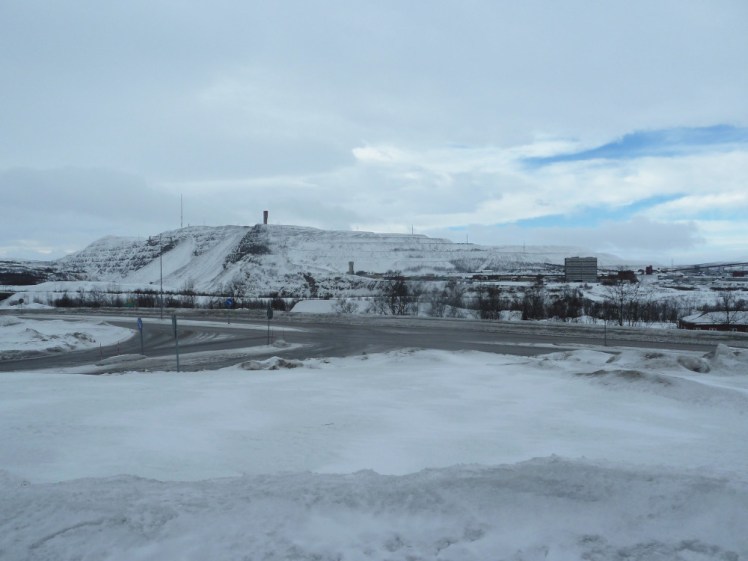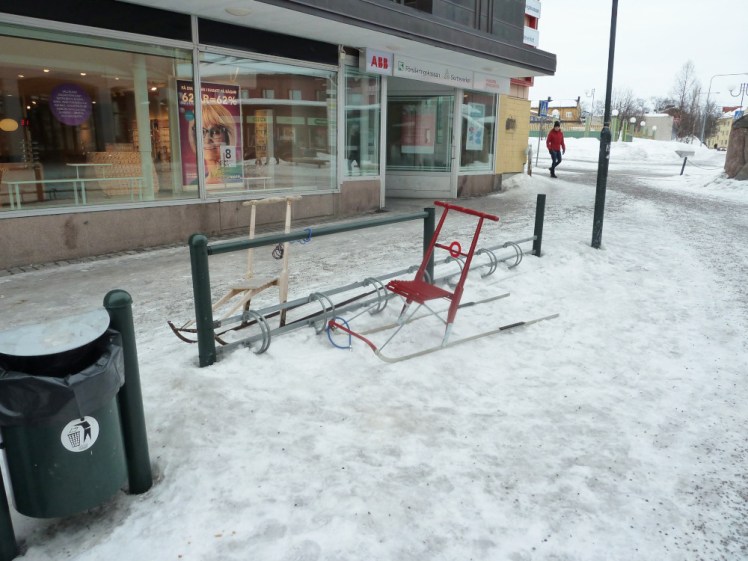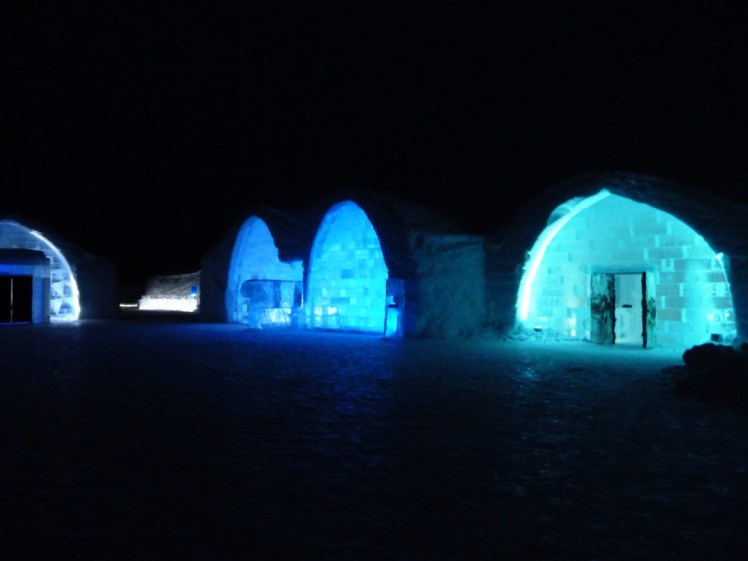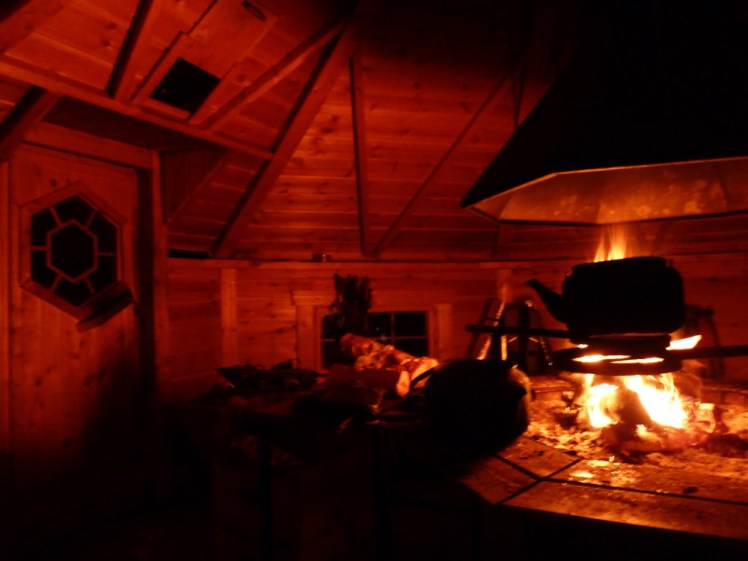Kiruna, in northern Sweden, is one of the oddest places and I have no idea why I haven’t written about it sooner.
In theory, it’s one of these places that just lights up with tourism in the winter. It’s just up the road from the famous ICEHOTEL (which from now on I’ll be spelling in the correct human way complete with definite article: the Icehotel) and it’s a paradise for winter sports. Spoiler: I snowshoed on a frozen lake and then we had a campfire in a barbecue hut. I tried and failed to book dogsledding. The Icehotel can organise snowmobile rides and wilderness adventures, you can take the dogsled to the hotel from the airport or go out with them for lunch or to see the Northern Lights. There’s cross-country skiing, wildlife safaris, visits to Sami homes, saunas and spas of all kinds. There’s no shortage of winter activities to do. I was a bit of a fail in not filling every second of my 48 hours in Arctic Sweden because there’s a lot you can do.

And then there’s the mine.
Kiruna is a mining town. Specifically, it’s an iron ore mine – the biggest in the world. If you live in Europe and you have anything in your house that’s been made from iron in the last 100 or so years, the iron probably started in the mine at Kiruna. It’s the largest “and most modern” underground iron ore world in the big, it’s 2km deep in places and it’s now so big that the town is being moved to prevent it falling in. Yes. The mine is so important and so valuable that Sweden is willing to do something unprecedented and move an entire town.

Oh, some of it will be left behind and demolished but important buildings are literally being shunted onto lorries and driven to the new town. It’s incredible.
So…
Kiruna is home to the world’s largest underground iron-ore mine, LKAB, and mining is causing the ground to crack and cave in so our town has to get out of the way.
Today the people of Kiruna came out to watch this apartment building move. pic.twitter.com/yFfPs3RxbI— Mia Stålnacke (@AngryTheInch) October 12, 2019
https://platform.twitter.com/widgets.js
Mia here lives in the area and took these photos in 2019, in case you thought I wasn’t being literal.
I was there in 2014 before most of the work had begun – and indeed, before they’d decided for certain where the town was going. At the time, the main station had closed and the railway had been moved, which required me to walk a mile or so up the road, in the snow, with a suitcase, to a station made of a couple of platforms and a shipping container, where there was no train anyway because a cargo derailment in the morning had closed the line. You can read the story of my subsequent trip to Norway by bus here.

Yeah, I didn’t do enough with my 48 hours there. I arrived in the middle of the afternoon of 13th March and spent that day getting accustomed to the town, getting some food and trying to book activities. Moral of the story, I think – book the activities in advance.
I bought a Sweden and Sami flag patch for my blanket and I picked up a piece of Kiruna iron ore. There was a basket of marble-sized pieces you could help yourself to outside the tourist information office, so I did. Another thing I could and maybe should have done – you can do a tour of the mine. I knew that the town was at risk of falling in and there’s a model in the tourist information so I knew exactly how big the thing is but… I don’t think I realised how big the thing is.

I did get to know Kiruna a bit. I walked around, found the old station, figured out some Swedish and found some ice sculptures, proper abstract weird sculptures, nothing obvious like snowmen or eagles. They’re just on the hill on the way up to town from the station.

There’s grit embedded in the ice on the streets. I guess it gets gritted so people can walk and then it snows again and the snow and grit build up alternating layers. It all looks odd and to be honest, it all looks dirty. In Narvik a couple of days later, I saw that they sweep up the grit to reuse it and I assume that happens here, but Narvik is an ice-free port because of the Gulf Stream so it all happens a lot sooner there on the coast than here in the middle of Sweden. I watched old ladies go out and do their shopping. They take their shopping trolleys, just like old ladies everywhere but in Kiruna, those trolleys take the form of ultra-lightweight mini sledges with their names burned into the crossbars in curly letters. You see these things locked to fences and lamp posts outside shops.

Then I went round to the church. I took it to be a variety of stave church since it’s made of wood but apparently it’s Gothic Revival. It’s hard to be sure about these things when you haven’t yet taken an interest in ecclesiastical architecture and when the church looks like it’s slumped in the snow. It’s reddish-brown wood with sloping roofs on all sides and a big window at the top of one side. I knew I wasn’t in love with the inside and now I discover that the altar is Art Nouveau. Not my thing. I like Norman and I like Perpendicular Gothic.


But the highlight of those two days was my evening out. I joined a tour with an older couple. I think it was just the three of us and they were staying at the Icehotel. I went to the tour’s HQ and was fitted with a pair of plastic snowshoes and given an armful of poles – two for me and two sets for the others. Then we drove down to Jukkasjärvi to pick up my fellow snowshoers from the Icehotel. That took a couple of minutes so I was sent to run down the path to have a quick look at it. This is another thing you can do as a tour, come and visit the Icehotel by day. It’s far too cold to spend the day hanging out in so guests don’t go to their rooms until fairly late and they leave fairly early, which means it’s empty during the day and just ripe for tourists to amble around.
In case you haven’t come across it, this is the original hotel made out of ice. They carve blocks out of the river every year and freeze them throughout the summer before building it when the weather starts to get cold. The first one was an art installation which some tourists asked to sleep in when they failed to find any accommodation. Seeing that people would pay a lot of money for the novelty of sleeping in a building made of ice, the Icehotel and many replicas have followed. I sometimes say “Oh, I know it’s expensive but just that once…” and then I look at the prices. The cheapest room, a standard double room, mid-week in February (I’m looking for low-ish season) is 6995SEK for one night, which is £554/$640. I suppose it’s not that bad but it’s bad enough for me to decide that winter camping in Hampshire will have to satisfy my urge to spend a night trying not to freeze to death (I’m referring to Sparkle and Ice, which is an event happening soon and the blog post will be up early December).

In the winter of 2013/14, it seemed to be built in the style of railway arches, lit in shades of blue and green. Or at least, that’s what I saw of it in the dark. It was closed to the public by this hour but I’d seen it and that would have to satisfy me. I was a bit surprised to discover it had big iron warehouse-style doors – well, of course they’re iron! – but I guess you can’t really make a door out of ice. It just looked a bit more utilitarian. This would have been post-Frozen and possibly even I had seen it by that point. Yes, I had! January 17th 2014 – I have the booking email still. I don’t think it had embedded itself in my brain less than two months later, though – I don’t think I was expecting something like Elsa’s ice palace, exactly – but I was expecting something more ice palace-like. This was verging on the industrial and it just wasn’t what I’d pictured.

Anyway, I got less than five minutes to take it in and then we were in the minibus and driving down the road to a campsite by the frozen lake. Our guide, whose name was Emilio, went into the barbecue hut, picked up a handful of birch bark, flint and knife and then with a twist of his hand, he just lit the fire. Just like that. I swear I’ve never seen anything so like actual sorcery in my life. He left the fire to do its own thing, keep burning and warm up the barbecue hut and we put on our snowshoes and headed out.

I lost a lot of my illusions about the Arctic on that trip. I’d been to Iceland a few times by then but I think this was my second time within the Arctic Circle and the first time had been in late May, when I’d gone around in shorts and sandals. I thought snowshoeing was going to be beautiful and silent and serenity made physical and it wasn’t. At best, I sank to knee-depth into the snow on every step. Most steps I fell in. You can’t push yourself up and forward because of the depth and the softness of the snow and you just flop face-first. Making any progress is exhausting and frustrating and you get very hot very quickly. And I was the only one having that trouble. Remember the scene in Lord of the Rings where they’re crossed the Pass of Caradhras? Everyone’s struggling through deep snow except Legolas who just walks on it as if there’s no snow at all. I felt like the one dwarf in a company of elves on that evening.
Here, this one. I mean, if I was a Tolkien character I’d be a dwarf anyway. I’m far more suited to the dark places beneath the Earth. Should have gone to that mine.
I fell in three steps in a row. I couldn’t get up on my own. I had to have a foot physically dug out of the snow by Emilio. I lost a snowshoe. I hated it. See, when you try to walk and you sink, that foot slides forward. It slides under a load of snow. You have to unhook it before you can pull it back up and that means trying to walk in snowshoes can be a bit like trying to learn to moonwalk.
Then we reached a road. It was still snowy but it wasn’t two solid feet of snow. You could drive on this, if you had suitable tyres and/or chains. There were moose hoofprints because it turns out the animals also prefer to take the easier option. The lake was even better. There’s about half a metre of ice with a good sprinkling of snow on top and that was easiest to walk on. Emilio took our photos and I opted to deliberately lie down because I felt my official photo should mirror what the occasion was actually like.

I’d never thought that the locals use the lakes and rivers to drive on. But it’s more than solid enough to drive a snowmobile on, or even a car. It has a speed limit and the police come out with their speed guns to make sure no one’s speeding. They even send up the helicopter to watch over things sometimes.

We walked back to the hut where somehow the fire was still blazing. Not only had I witnessed witchcraft in the making of that thing, it could only have survived the last hour or two with the aid of more magic. Now was our “fika break”, the first time I’d encountered fika. I stripped off all my sweaty clothes – no need to worry about being cold when the fire was so bright.

Emilio made reindeer sandwiches and moose sausage, which I declined, but I had hot chocolate. I don’t remember whether the sandwiches and sausages came ready-made as a picnic but the hot chocolate was definitely made over the fire on a proper iron kettle. I’d never seen anything quite like the cup this was served in: the phrase I used in my diary was “a plastic container that I suspect wasn’t actually designed to be a cup” which I’ve since learned to recognise as a uniquely weird style of camping mug that, frustratingly, I can’t find right now.

I never expected snowshoeing to be either so difficult or such hard work and a campfire is 100% what you need to recover afterwards. By the time you read this, I’ll be packing to go glamping and then to go to Germany and I’ll definitely be having a hot chocolate in front of my log burner in the shepherd’s hut. Lighting a fire in a Frankfurt hotel might not go down so well but I’m going to the Christmas market so I’m sure there will be hot chocolate available.